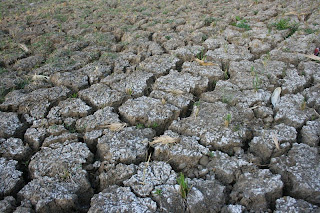




(c)AC Dimatatac
Isabela is the second largest rice producing province in the Philippines and the first when it comes to corn production. As early as February of this year, several towns were declared under the state of calamity due to extreme El Nino that brought severe drought in their farmlands. About 3 billion worth of damage crops have been reported as of March 2010. Almost all of the rice and corn crops planted last December harvested and if it did, it was either burnt for the corns or in the case of rice it just produced ipa or empty grains.
According to Mr. Emiliano Camba, manager of the Farmers Information Technology Services
(FITS) and the Municipality Agriculturists Officer (MAO) of San Mateo, one of the contributing factors to the problem they are facing right now is the type of soil in Isabela. Most farmlands in this province is Sandy Loam, the kind that must be maintained with water every 24 hours and because there is no water to irrigate their crops, they are unable to harvest it. Meanwhile, in other towns like Alicia and Santiago, they have Clay Loam, or the type of soil that can survive for a week without water. This has lessened the impact on their crops.
San Mateo, is one of the areas heavily affected by the calamity. Recognized in 2008, this town is also known as the Agro-Ecological Destination in Isabela. About 8,400 hectares of farmland were planted with rice and 792 hectares for corn. They rely on the weekly distribution of water for their irrigation from Magat Dam, but since the Dam was closed they haven’t had enough water supply for their farms. The Department of Agriculture (DA) provided them with 70 water pumps which were distributed evenly to those heavily affected and to those who still have water to pump. Despite the efforts, the pumps came too late --- there was no water to pump.
For the farmers who were able to harvest their crops, they reported huge losses from their average of 6.2 to 7 yield which can harvest at least 300 bags per hectare. Since the drought, they were only able to produce 70-80 bags, a far cry from the usual 300 bags. According to Mr. Lito Lazaro, a farmer in Baranggay Salinungan his 1 ½ hectares farm of rice can produce up to an average of 50 bags per harvest but now it’s gone down to 20. He can only sell his rice for P14 per kilo and P10 for the poorer quality. In Macarasat Piqaño, Captain Binerando Gamiao showed us his corn farm and its crops which are smaller than the normal size and some already burnt. He said because of the poor quality, he can only sell it for feeds – and not even all of it.
Grace Padaca, the governor of Isabela extended her help to those affected by giving out 5 kilos of rice to the farmers in the most affected areas. They gave rice in two baranggays in Naguillan, Minanga and Minallo.
Mrs. Lydia Botten, a resident of Minanga for 45 years, was able to harvest around 25 bags both for her rice and corn crops which is only ¼ of her regular harvest, a staggering decrease from her average harvest of 100 bags. In purok 7, Sitio Pikot the farmers were not able to harvest anything. Meanwhile, Brgy. Minallo suffered the most as the irrigation did not reach their area. One of the farmers, Mr. Augusto Villamor said his usual 100 bags of yellow corn feeds went down to only 20 bags. Normally, he can sell his crop for P16 per kilo but now he can only sell it for P12.50.
Meanwhile, people in Baranggay Malalatang Tungi in Reina Mercedes were hit hardest by El Niño.According to Mrs. Elvie Manuel, wife of the Baranggay Captain, they unable to harvest
anything from their rice land and only a few from their corn land. The type of soil in this area is Sandy Loam, so even if they are geographically close to the Magat River, their crops weren’t able to survive the drought.
This really shows how devastated the farm lands of Isabela are and how farmers are faced with a difficult situation that leaves with them with practically nothing to earn from. Despite the help form both national and local government, it is not enough to help them survive the crisis of El Niño. They have not given up, for they continue to hope and pray for rain to save them from the drought.
No comments:
Post a Comment